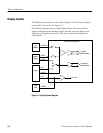
Theory of Operation
2715 Spectrum Analyzer Service Manual
3-13
The 110 MHz 2nd IF is amplified and divided along two paths. One path is
through a buffer amplifier to the sweep board where the signal is available to the
satellite demodulator. The second path is through a PIN attenuator which sets the
gain of the module. The signal then passes through a second amplifier stage then
a 110 MHz Bandpass filter. This filter has a 3 dB bandwidth of 5 MHz which
sets the widest resolution bandwidth of the instrument. After the 5 MHz filter,
the signal is again amplified and applied to the 3rd converter.
The 3rd IF is created by mixing the 2nd IF with the 100 MHz reference to create
the 3rd IF frequency of 10 MHz. The mixer output is filtered to reduce the 2nd
harmonic level, and then amplified before being applied to the VR module.
This section describes specific elements of the RF Mother board.
2 GHz Phase locked LO. The 2nd local oscillator is formed by Q112 and C204. In
this configuration, the VCO oscillates into a 50 Ω load. The resonator ensures
that this frequency will be close to 2 GHz. The VCO is tuned by varying the
emitter base voltage, which causes that junction to act as a varactor.
A sample of the 2 GHz signal is divided by 4 (U424) and sent to a mixer/phase
detector (U511). The mixer is driven by the 100 MHz reference, so the DC mixer
output is created by the divide-by-4 sample and the 5th harmonic of the
100 MHz reference. This signal is integrated (U444) and connected to the Q112
emitter, closing the loop.
U230A provides a clean --8 V bias to Q223. If the loop is unlocked U230B
causes the control loop to oscillate, sweeping over its full range until lock
occurs. C323 (10F) and related circuitry insures start up by pulling the control
voltage high at turn on.
2nd Mixer. This single balanced mixer is formed by CR223. The 2 GHz 2nd LO
is applied to the diodes through amplifier (Q322), and the 2.11 GHz input and
110 MHz 2nd IF are separated by a filter.
110 MHz Amplifiers. These IF amplifiers consist of common emitter transistors
(Q130, Q140, and Q150) with both series and parallel feedback. The 1:1 trans-
formers (T130, T140, and T150) provide lower output impedance for better
intermodulation distortion performance.
PIN Attenuator. CR369 and CR367 are PIN diodes and are used to adjust the gain
of the module. PIN diodes behave like resistors at RF frequencies, with the value
being dependent on current flowing in the diode. (High current, low resistance;
low current, high resistance). Current through CR369 decreases attenuation and
current through CR367 increases attenuation. R200 adjusts the current through
the PIN diodes and has a range of approximately 15dB attenuation.
Detailed Circuit
Descriptions


















